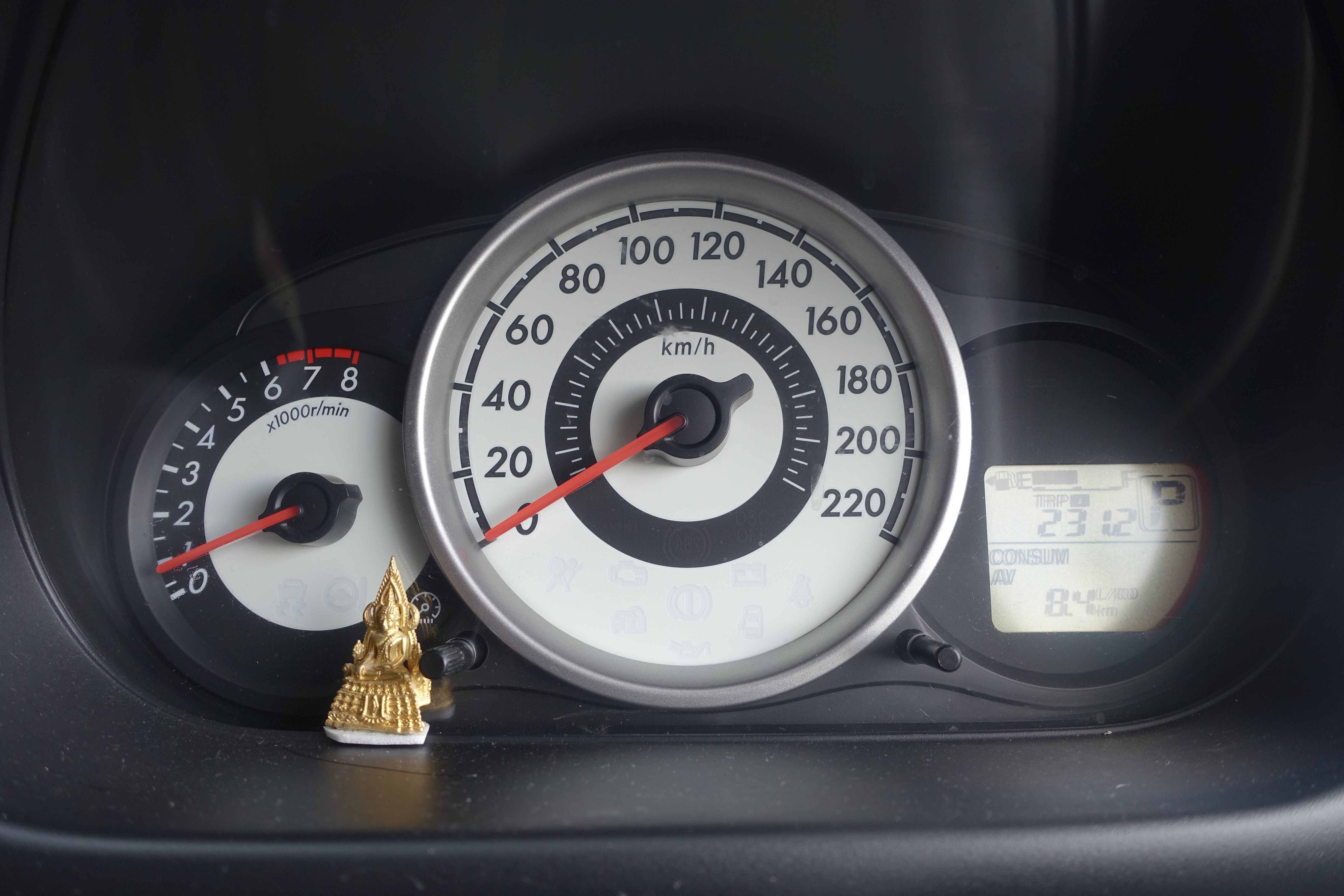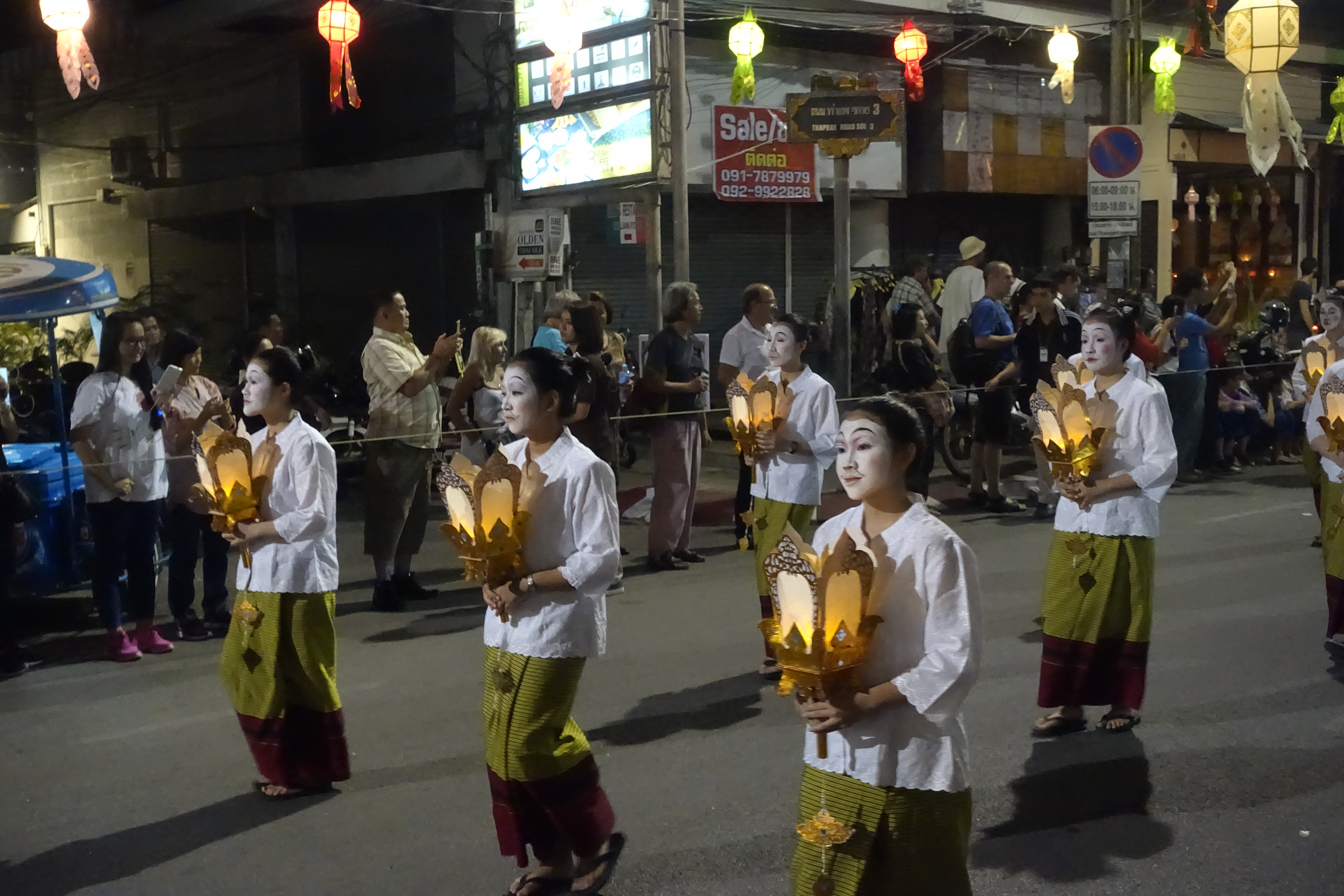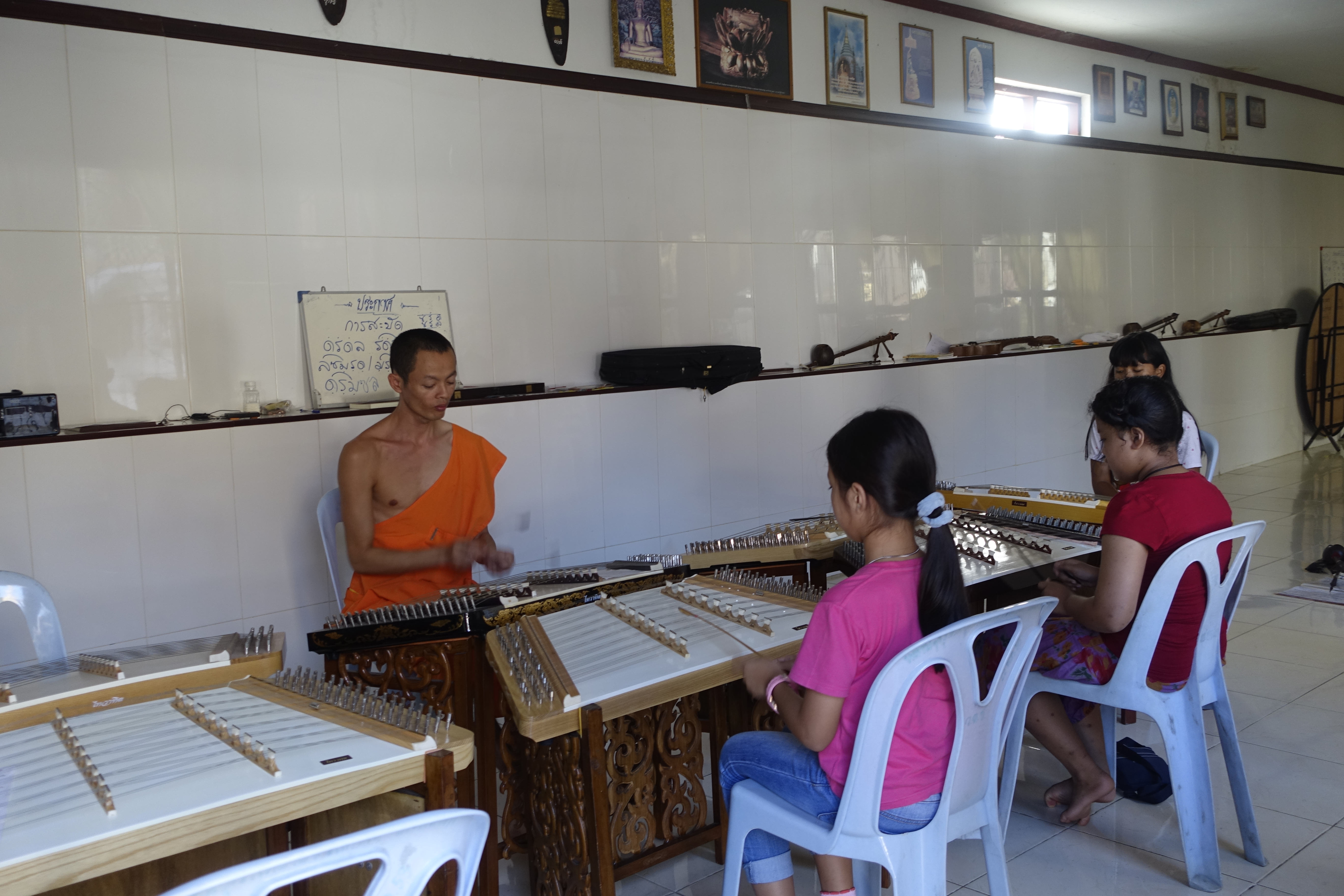Bangkok, Thailand
After the crowded carnivals and explosions of Loi Krathong, it was time to head out to the mountains and quiet little villages of the far north of Thailand. I decided to rent a car for the journey, and for the first few days, I brought along my Dutch friend Leander, whose tendency to say little, demand little, and answer most suggestions with, “Yeah, sure,” made him an excellent travel companion. Plus he was good about releasing the hand break when I’d forget.
Wrong side of the road
In Thailand they drive on the left side of the road. Adjusting is less tricky than you’d think — not much worse than switching from your regular coupe to your parents’ giant SUV — but the main thing to remember is that you have more car than you think you do to the left of you, and less car than you think you do to the right. There’s a tendency to drift left, which is how I’d slipped my rental car into a ditch on a dirt road in the pouring rain in Ireland many years ago. In Thailand, though, after nicking my left-side mirror in the narrow streets on the way out of Chiang Mai, I didn’t have much trouble beyond reaching to the wrong side for my seat belt or turning on my wipers instead of the turn signal.
The car gave us a certain freedom to stop where we wanted, to head down byways and chase after oddities. Our first whim was an attempt to double back to what looked like a Khmer ruin by the side of the highway. We turned off into a little village, found ourselves on a narrow residential street whose concrete gave way to dirt, and backed out again. After taking the more sensible route of driving further down the highway and making a legal U-turn, we discovered that the Khmer ruin was in fact a newly constructed tourist trap over one of the region’s many hot springs.
Chiang Rai (photos, White Temple/Black House photos)
Chiang Rai is a small city in the north of Thailand that serves as a base for treks into more rugged regions and as the jumping off point for trips to the Laos border and beyond. The town itself is dominated by the art of Chalermchai Kositpipat, creator of the White Temple and designer of Chiang Rai’s flamboyant street lights, bridge decorations, and singing clock tower. Chiang Rai also has a night bazaar with mediocre food and weird floor shows, a thriving cafe scene based on the region’s coffee crop (including a cat cafe), and one tacky bar street that replicates Bangkok’s Khao San Road or Chiang Mai’s Loi Kroh Road in miniature. (We ran into Paul there, whom we began to call The Inevitable Dutchman of Pai; his entourage that night included an aging Thai bar girl in a ship captain’s hat.)
I had a sense, strolling around, that Chiang Rai felt more like Korea than anywhere else I’d been in Thailand — an odd reference point, I know — and I think it’s because it’s got more influence from China, which is only a couple hundred kilometers away. Well, that and it has a cat cafe.
Chiang Rai’s most famous attraction is the White Temple, and its second most famous attraction is the Black House, which serves as a kind of counterpoint. The White House is better known, maybe more photogenic, and the lesser artistic achievement. Despite its grandiosity and fine detail, it falls into the realm of folk art: an artist’s riff on Thai temple architecture and Buddhist iconography, populated with literal representations of everything from movie characters to 9/11 and the Space Shuttle. It’s earnest to a fault.
The less celebrated Black House — really a compound, created by Thawan Duchanee — is the greater work of art. You might dismiss the skeletons, the animal skins, the furniture made from so many black-painted water buffalo horns as so much gothic nonsense, but I sensed that there was something deeper going on. The fifteen buildings that make up the Black House Museum are mostly riffs on Thai temple architecture, but elongated or heightened or flattened; the remaining buildings call to mind Tibetan stupas, but also the bulbous utopian architecture of places like Arcosanti. Here and there on the grounds are assemblages of stones into a triangle, a circle, a spiral. They’re like archaeological finds, full of forgotten symbolism that can only be guessed at, and also connected to the earth works movement of the seventies. The whole place felt like a cross between a cult headquarters and a conference center, what with Duchanee’s fixation on creating dining tables covered in skins and Buddhas and surrounded by creepy horn chairs. Is it Buddhist? Anti-Buddhist? Satanic? A great place for Motorhead to do a photo shoot? Unlike the White Temple, the Black House holds onto its mysteries.
Ban Tha Ton (photos)
Ban Tha Ton is a tiny little nothing by a bend in a river in the mountains north of Chiang Rai. It has far more guesthouses than it needs, a multi-part temple on a hill, a bunch of restaurants that don’t seem to produce any food, and a lovely setting that makes people say it will be the next Pai. It has the right mix of beauty, ambition, and ineptitude. After six in the evening, the hub of activity is the 7-Eleven, just down the road from the bridge over the river, which is elaborately lit up with strings of LED lights that change color.
There isn’t yet much to do in Ban Tha Ton. (Ban means house, literally, and is put in front of the names of villages.) We toured the temple, and then we were done for the day, and it was only two o’clock, so we decided to drive to the nearby town of Mae Ai (mae means river), which is a little bit bigger and much less attractive. Now what? I looked at Google Maps and saw that instead of taking the main road back, we could instead follow a big squiggly loop that would take us close to the Myanmar border.
The steep road climbed up into the mountains, pushing our little Mazda 2 to its limits: I would be flooring it, and we’d crawl along at 30 kph. Leander said it felt like we were in a Top Gear adventure. But we were now away from the places outsiders usually go. We passed through tiny villages of wooden houses with thatched roofs, and now and again a beautiful new temple. There was a jarring quality to the juxtaposition: Thailand seems to pour endless resources into vast, shiny new temples and royal spectacles in even the most remote areas, while the people who actually live there still lack modern roofing materials.
Back at the Apple Resort, there was a menu went on for pages and offered such exotic fare as wild boar and local fish. The hotel staff, however, seemed concerned about what they had in the kitchen — maybe some chicken? — so we decided to cross Ban Tha Ton’s elaborately lighted bridge and go to the town’s one functioning restaurant. It was where the other foreigners were too, not a lot of us, mostly older folks who could afford their own wheels. The food was simple but good, and we could watch the action at the 7-Eleven across the street, which was the hub of the town’s nightlife.
Mae Salong (photos)
The next day we headed to Mae Salong, a mountain village with a curious history. When the Chinese civil war came to an end, most of the Guomindang (KMT) armies retreated to Taiwan. But in outlying areas, a few remnants kept up the fight. Some 12,000 troops in Yunnan fought their way into the jungles of Burma, where they spent some dozen years battling the Burmese army and trying to retake Yunnan, assisted by weaponry provided by the CIA in exchange for intelligence about China during the Korean War.
In 1961, the remaining 4,000 soldiers (some had been evacuated to Taiwan) were offered asylum in Mae Salong, where they would offer their services in fighting communist insurgents. The warfare continued until the 1980s, financed now by the region’s thriving opium trade. It wasn’t until the Shan separatist drug lord Khun Sa (more about him later) was finally defeated by the Thai government that the KMT army finally laid down its arms and became Thai citizens, along with their families.
What remains is a charming mountain village that has the bustle and energy of the Chinese, where people say xie xie instead of kop kun ka and you can get an excellent bowl of noodle soup. There’s a KMT museum and memorial to the fallen soldiers, which describes many battles but fails to explain where these troops got their food or their wives during all those years in the wilderness. Since the region fell under some kind of rule of law again, in the 1980s, though, there seem to have been attempts by the Thai and Taiwanese government to retrain the locals as farmers of legal cash crops like coffee and oolong tea.
Mae Salong is another place that sometimes gets mentioned as the next Pai, but I don’t see it. First of all, it’s too mountainous: there’s no central part of town that’s easy to walk around the way there is in Pai or Ban Tha Ton. But beyond that, the energy’s all wrong. The Thais are a mellow people, but the Chinese are not. Despite its small size, Mae Salong was full of activity, with a vibrant afternoon tea market and a small but energetic morning market where we got Chinese fried bread and soy drink.
During the day, we drove a loop through the mountains to various tribal villages, then made a long drive out to a place no one goes, Ban Thoen Thai. There’s one guesthouse, where we hoped to stop in for information but could find no one working, and there is a museum in what used to be Khun Sa’s encampment. The tenor of the museum is startling: it glorifies Khun Sa as a Shan separatist, documenting in detail the Shan’s legal right to secede from Thailand, and suggests that all the opium dealing was a regrettable way of financing a righteous war. (All this separatist literature is overseen by portraits of the king and queen of Thailand, of course.) There is a life-size statue of Khun Sa, complete with a sparkling lavender ring on his finger. There is also supposedly an adobe temple somewhere nearby, but no one in town had ever heard of it.
Doi Tung and Chiang Saen (photos)
The third day out of Chiang Rai, and my last with Leander, we headed for Doi Tung, whose temple supposedly had the best views of any temple in Thailand. It was another long but lovely drive through the mountains, but when we got to the temple, perched high on a mountain, we found that every possible viewpoint was blocked by trees. We caught glimpses of spectacular vistas on the narrow roads around the temple, but there was nowhere to pull off and really look. Taking another tack, we tried pointing the car at any road that went further up and found our way to an arboretum that charged us B100 to enter. There was a pretty impressive lookout toward the Burmese side, but the highest points, which would have offered broad views down into a valley and across to Laos, were again blocked by trees. It was an arboretum, after all.
We decided to give it up and just drive to Mae Sai, at the northern tip of Thailand. Google Maps steered us further up the mountain, and then we came to what looked at last to be the spectacular viewpoint we’d been hunting.
It was also a Thai military site, and the border checkpoint with Myanmar.
The views were in fact spectacular, in all directions, and it was cool to have come that close to Myanmar. We did not, however, think it was a good idea to take our rental car across an international border, which is where the road went. Google Maps might want to have a feature that warns you that you’ll be crossing borders if you follow the directions given.
Having come so close to the border, we didn’t see much point in driving on to Mae Sai, so we circled back down and across a plain to Chiang Saen. We stopped in at the Golden Triangle, the point where Laos, Myanmar, and Thailand meet, and spent some time at the Opium Museum, which was better than I expected it would be. Chiang Saen itself has some old ruins and is boring and we were tired. We gave up on the place quickly, turned back to Chiang Rai, had an overpriced pizza for dinner, and said our goodbyes.
Chiang Khong to Ban Huak (photos)
I was now on my own. I woke up early and headed out, taking the scenic route across the plains to Chiang Khong — the same place, incidentally, where Leander would have gone by bus that morning to get the slow boat to Laos. I stopped in at Bamboo Mexican Restaurant, recommended by the Lonely Planet for its tasty whole wheat bread and good coffee, and then I took a turn south into some of Thailand’s most spectacular mountains.
Being on my own was an interesting shift. Leander’s about as easy as a travel companion gets, but I still had the decency to ask him before stopping somewhere or pulling off down a side road or flipping through the radio. Now I could just do whatever I wanted: listen to whatever weird, awful music I could get reception for, stop by the side of the highway to take a picture of a corn silo, drive painfully slowly.
It was also a good chance just to think. I’d gotten the news the previous night that a dear friend’s mother was dying, and it hit me hard. I’m on an extended holiday, where my big concerns are whether my hotel will be nice and where to get my next plate of noodles. But the real world goes on back home. My heart ached for my friend, who had already lost her father some years ago. I was glad to have time to wind along mountain roads, look out at beautiful views with the windows rolled down and the sounds and smells coming in, and let my mind wander.
I was on my own in another way too: once I got beyond the border town of Chiang Khong, there were no more Westerners. (Well, very few. I saw five, to be exact.) I drove up and down steep, winding roads, climbed to the tops of Doi Pha Tang and Phu Chi Fa and watched walls of fog rise up out of Laos, stopped to watch farmers working on impossible slopes. I drove past countless resorts that seem to have been built in frenzies of overcapitalized optimism, with nary a tourist — or an employee — in sight. By the afternoon, I was mostly just driving along in search of food, and finally found it at a little park by a thermal waterfall — the water is heated underground — and then I had a decision to make.
Phrae (photos)
It was getting on past four, the sun low in the sky now. Where would I spend the night? Phayao was the obvious choice: a lake town about ninety minutes away. But nothing about it called to me. I’d been thinking about Phrae ever since I got my Thailand Lonely Planet, which called it out as a little-visited city that resembled Luang Prabang in Laos. I wanted to go to this place no one goes, and never mind that it was still more than three hours distant.
I’d been driving all day, and three more hours was grim, especially once the sun went down and I was leapfrogging trucks on winding mountain roads in the dark. There would be lighted stretches, and then we’d be back into darkness and blind turns, and sometimes fog. But I made it, pulling into the city of Phrae and parking at a teak hotel without an English sign (a Lonely Planet recommendation).
Phrae is a pleasant little city full of teak houses, monks, temples, and nasty temple dogs that come out and growl at you until a monk chases them off. There’s not that much to it, and I’d seen what I’d come for by noon the next day. Was it worth it? Was it worth the extra hours of driving and the exhaustion and the $30 of extra fuel? Who knows? In twenty years, I won’t be worried about the gas money or my sore butt, but that doesn’t mean they weren’t a problem at the time. I was glad, in any case, to have pushed on to a place I wanted to see, and to spend a night and a day in a Thai city that is so not oriented toward foreigners that even the restaurants for tourists don’t have English signs, and the lady at my lunch place, which is listed in the Lonely Planet, was excited enough that she insisted on snapping selfies with me.
And then it was back in the car for the long drive back to Chiang Mai and its expats and big international hotels. After a week in the hinterlands, CM felt positively metropolitan, and it was good to spend one more evening with my friend Jacob, an ex-Googler expat who calls Chiang Mai home. The next morning I took my little Mazda 2 to the airport, handed it over, and headed back down to Bangkok, where I would soon find myself in a giant crowd celebrating the king’s birthday.



